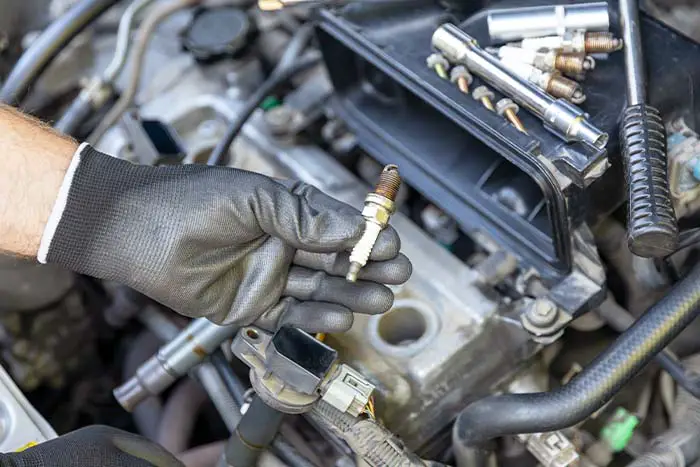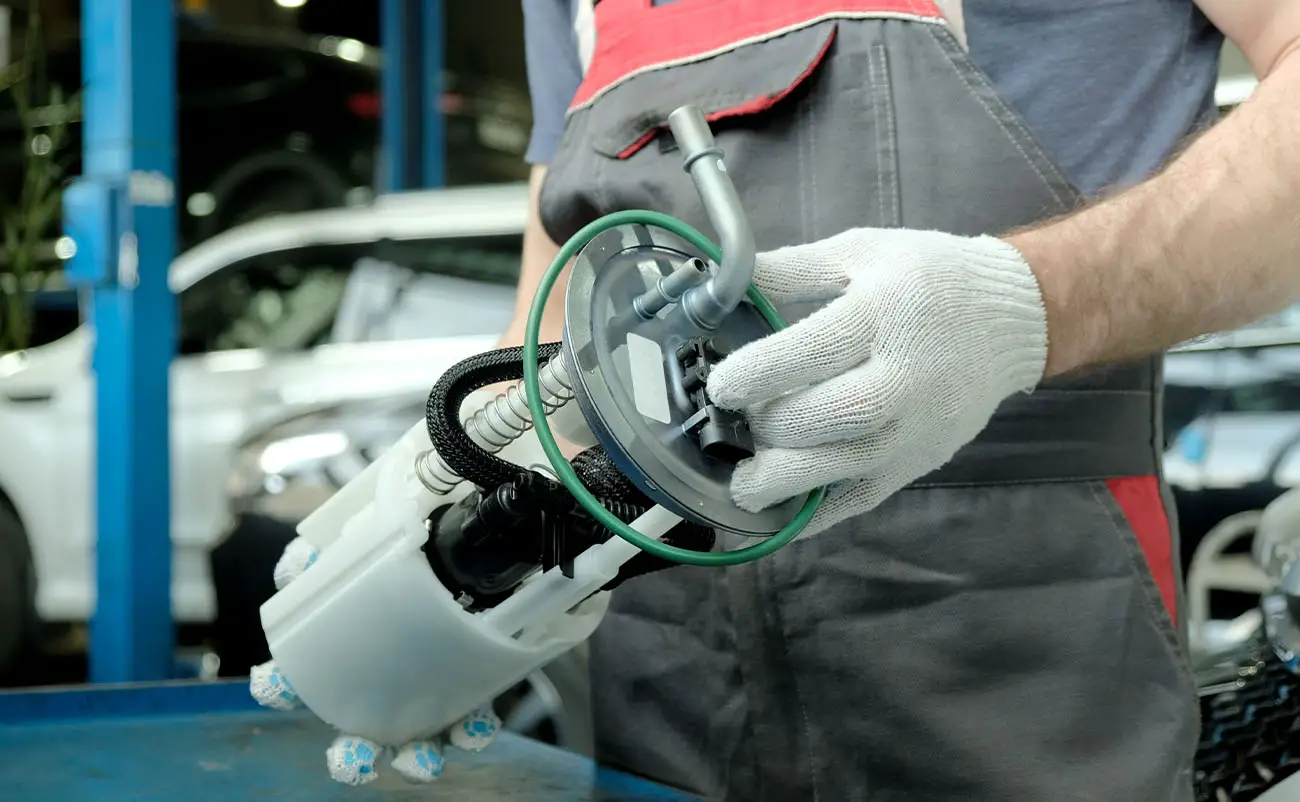Your car’s fuel pump is one of the most important parts of the fuel system. The pump allows the fuel from your fuel tank to travel to the engine. Most gas tanks are located near the back of the car, while the engine sits at the front. A pump is required to pump the fuel from the tank to the engine.
When your fuel pump fails, you will know immediately. Your engine will stall, and the car will not restart. You will need a tow to a repair shop to replace the fuel pump. So, how much does a fuel pump replacement cost? We will give you all the details and some tips for performing the job yourself.
Table of Contents
How Much Does A Fuel Pump Replacement Cost?
The average fuel pump replacement is likely to cost you somewhere between $600 and $1,200. The exact repair price will depend on your vehicle’s make and model. The type of fuel pump on your vehicle also plays a significant role in the cost. Older vehicles may use a mechanical fuel pump that connects directly to the engine. These fuel pumps are much easier to access and replace. The cost of replacement could be as little as $200 in some cases.
However, most modern vehicles use electric fuel pumps. These fuel pumps are typically located inside the gas tank. Therefore, the mechanic must remove the gas tank to get to the fuel pump. An electric fuel pump also costs more than a mechanical pump for the part alone. The average cost to replace an electric fuel pump will usually run you $600 to $1,200, although some high-end vehicles, like a BMW, might cost even more than that. Since the fuel tank must be removed in most cases, a large part of the bill will be from labor costs.
Symptoms Of A Bad Fuel Pump

Since a fuel pump failure will leave you stranded; you might be wondering if there are any warning signs before your fuel pump completely fails. The answer is yes. While you might not always notice any bad fuel pump symptoms before failure, there are a few things that you can watch for. Here are the signs that your fuel pump is going bad.
— Engine Misfiring
Engine misfires could be a sign that your fuel pump is failing. More than likely, a misfire will trigger the check engine light. You might be able to get more details about the misfire by having an auto repair shop read the trouble codes for you. Misfires can be the result of many different problems, like bad spark plugs, improper ignition timing, clogged fuel injectors, or a failing fuel pump. If your fuel pump is not strong enough to deliver the proper amount of fuel pressure, you might not have enough gas to make it into the combustion chamber. A misfire might result, and you might need to get a new fuel pump soon.
— Difficulty Starting
Your fuel pump must deliver quite a bit of fuel to your engine at startup. Since the engine has been shut off, there is typically very little fuel in the fuel lines — especially for cold starts. For this reason, the pump must deliver a higher volume of fuel than usual when attempting to start. When your pump starts to go bad, it might not be able to deliver the amount of fuel necessary to get the engine started. So, hard starts can be a definite sign of a fuel pump that is going bad.
— Whining Noises
Many electric motors begin to whine when they go bad, and electric fuel pump motors are no different. A whining noise that sounds like it’s coming from your fuel tank can be one of the signs of a bad fuel pump. The vehicle’s fuel pump might be close to failure in this case, so you should have it checked by a mechanic soon. Try sitting in the vehicle and turning on the ignition, but don’t start the car. If you hear a whining noise, then you probably have a fuel pump problem. Remember that some older vehicles have mechanical fuel pumps, so you will not hear a whine from those before failure.
— Engine Surging Or Sputtering
If you have a surging or sputtering engine, it could be due to a bad fuel pump. This could also be the result of a bad fuel pressure regulator or a clogged fuel filter. Bad fuel filter symptoms can include surging and sputtering. Either way, sputtering often occurs when your internal combustion engine is not receiving enough fuel. A faulty fuel pump might work sporadically, which could lead to the surging or sputtering effect. Surging or sputtering can also be a weak fuel pump symptom, which means that your fuel pump still needs replacement. If you are experiencing these issues, you will likely want to head to your dealership soon to have your vehicle repaired.
— Poor Fuel Economy
Have you noticed that you are filling your car with gas more often? Poor fuel economy can be a sign of a bad fuel pump. While you typically expect a bad fuel pump to deliver too little fuel, that is not always the case. In some cases, your fuel pump might be delivering more fuel than is needed. This excess fuel can quickly show up on your bill at the gas pump. So, if you notice that your fuel gauge drops more quickly than normal, you might want to have your fuel pump checked. It might be starting to fail, and you should replace it with a new one before you get stranded.
Types Of Fuel Pumps
We have already mentioned that there are a couple of different types of fuel pumps. There are two main types, and we will discuss each of them in more detail here.
— Electric Fuel Pump
Most modern vehicles are equipped with an electric fuel pump that is part of your car’s fuel injection system. Electric fuel pumps are typically located inside the gas tank, and they deliver precise amounts of fuel to the system. They are much more efficient than older mechanical pumps, and they can certainly help you save money at the gas pump. An electric fuel pump works by using a small DC motor to pull fuel from the tank and send it to the fuel injectors. To help prevent the fuel pump from overheating, electric pumps are typically submerged in the gasoline in the tank to keep them cool.
— Mechanical Fuel Pump
Mechanical fuel pumps were prevalent in older vehicles with carburetors. This type of fuel pump is typically bolted to the engine, and there is a lever that goes inside the engine and sits on the camshaft. A gasket prevents oil from leaking, and the lever moves up and down as the camshaft turns. This movement of the lever uses a diaphragm inside the pump to draw fuel from the tank to the engine. Mechanical pumps are usually easy to access and replace, although they are not as efficient as electric pumps. Similarly, mechanical pumps have trouble delivering high fuel volumes in high-horsepower applications.
Tips For Replacing Your Own Fuel Pump
Have you decided that you want to save some money and perform your own fuel pump repair? Here are some tips you should consider before trying to save money on fuel pump repair costs. First, make sure that you have the proper experience to perform this type of car repair. Remember that you will be working directly with the gasoline in your car, and gasoline is highly flammable. Failure to do the job right could result in dire consequences.
If you have a mechanical fuel pump, the job is likely to be much easier. In most cases, you can disconnect the fuel hoses from the pump and remove the pump from the engine. Replace the fuel pump gasket and bolt the new pump back onto the engine. Reattach the fuel hoses and start the vehicle. Make sure there are no leaks and the job is done.
Replacing an electric fuel pump is usually a little more complicated. You will first need to determine whether you can access the fuel pump without lowering the fuel tank. If you cannot, you will need to drain the fuel tank and lower the tank so that you can get to the fuel pump. Disconnect the fuel lines and remove the old pump. Attach the mounting brackets to the new pump and place the new pump into the tank. Reattach the hoses and bolt the fuel tank back in place. Most people choose to go ahead and replace the fuel filter at this time as well.
The Bottom Line
So, how much does a fuel pump cost? Even though a fuel pump costs less than $100 in most cases, a fuel pump replacement is likely to cost you $600 or more. The reason for the high cost is the amount of labor involved with the job. Most modern cars are equipped with electric fuel pumps that sit inside the gas tank; therefore, the fuel tank must be lowered to access the fuel pump most of the time. If your car becomes difficult to start or is surging and sputtering while running, then your fuel pump might be going bad. You should have a mechanic test your fuel pump right away to determine whether that is the issue.
Frequently Asked Questions
Is it worth replacing a fuel pump?
If your fuel pump fails, you have no choice but to replace it. Your engine will not start again until the fuel pump is replaced and the fuel makes it to the engine. Unless your vehicle is extremely old and worthless, then it is worth replacing your fuel pump. Replacing a fuel pump might cost you $600, but your car will not drive without a properly working fuel pump.
What does a fuel pump do?
A fuel pump delivers fuel from the tank to the engine. Mechanical fuel pumps generally use a diaphragm to pull fuel from the tank. However, electric fuel pumps use a small DC motor to pump fuel from the tank. Regardless of the type of pump you have, the main job of the pump is to get fuel from the tank to the engine. This allows your engine to run and your car to drive.
What are the signs your fuel pump is going out?
There are a few signs you can watch for that might signal a bad fuel pump. First, you should listen for a whining noise coming from your fuel tank. This might be especially noticeable when you first turn on the ignition without starting the engine, but you might also hear it while the vehicle is running. A fuel pump normally makes a quiet humming noise, but a loud whine is a sign of a problem. You might also experience engine misfires, hard starts, surging or sputtering. Any of these issues can point to a bad fuel pump, and you should have a mechanic help diagnose the problem as soon as possible.

